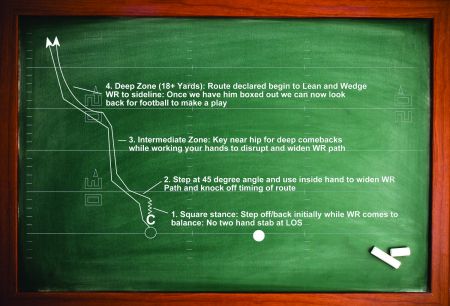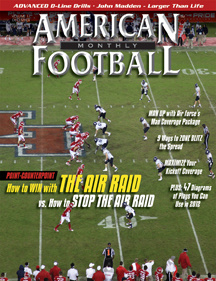Keys for Effective Man Coverage – Effective use of man coverage by your defensive backs can confuse the offense and put more pressure on the QB.
by: Charlton WarrenCo-Defensive Coordinator and Secondary Coach • Air Force Academy©
More from this issue
Effective use of man coverage by your defensive backs can confuse the offense and put more pressure on the quarterback.
One of the main reasons the Air Force Academy has been able to climb to the top five in the country in pass defense the last few years has been our ability to mix in effective man coverage. Based out of our 3-4 scheme, the effective use of man coverage has allowed us to vary our pressure package and also allowed us to be more aggressive in our coverages.
There are several reasons why we have decided to include more man coverage into our package.
1. Bring pressure from all angles: This allows us not to worry about match-up issues in nickel/dime packages and also allows those that who cover WRs to cover and let players (ILB, OLB, DE) who attack the box to blitz.
2. Change the QB’s tempo: Zone pressure allows the QB to recognize the 2, 3 or 4 deep zones and drop the correct pass off in “soft spots” prior to pressure arriving. Man coverage behind the pressure takes that soft spot away and forces the QB to hold on to the ball longer (allowing pressure to get to him) or throw the ball before the WR finishes the route.
3. Disrupt WR/throw route timing off: When we are in press alignments and hands-on with a WR, routes get disrupted, timing is thrown off and the comfort level of the WR is no longer there. Plays take longer to develop. With college football allowing DBs to be hands-on with a WR beyond five yards as long as the ball is not in the air, we have a great advantage to get physical and move WRs off their landmarks and out of their comfort zones.
4. Disguise: Man coverage allows us (depending on the formation) to have sometimes six, seven and maybe even eight players within five yards of the LOS pre-snap in a blitz situation. This also allows us to now bring pressure and hold our disguise until the ball is being snapped, and now the offense has a harder time checking protections. The QB also has a more difficult time figuring out if we are rushing four, five, six or even seven. This will, hopefully, result in a sack or an ill-advised throw into tight spaces and narrow throwing lanes, thus giving us a chance to make a big play.
Man Techniques
Throughout our man teaching, we have three primary ways we align and play man coverage. Like most teams we use Off, Press and Bail techniques.
Off-man technique allows us to not give the man concept away pre-snap and hold our zone Cover 2 shell. When we play off, we align 7-yards deep and 1-yard inside a normally spaced WR. Our eyes are on the QB through his 3-step drop. Once we recognize the quick game or when the QB passes through a 3-step progression, our eyes snap to the WRs. Even though off-man seems like the easiest man technique, I actually think it is one of the hardest. Off-man takes a tremendous amount of eye discipline for a pumped up 19-year old playing in front of a sold-out crowd. At every level of football – NFL, NCAA or high school – DBs often get beat on double moves. Each time, it is for one reason – they don’t have the proper eye discipline throughout the play and fall for a double move while staring at the QB.
Press technique starts with our feet square, a half-yard off the WR, our outside foot splitting the body of the WR and our eyes focused on the bottom of the WR’s numbers or belt buckle. The very first thing we do when the ball is snapped is take two kick steps back while staying on the balls of our feet and keeping our shoulders forward. As the WR takes his come-to-balance step or gather step at the LOS, we want to create about a yard of separation. At this point, as the WR crosses the LOS, we step at a 45-degree angle and collision the WR with our opposite hand and widen the WR on his departure. We now continue to be hands on, disrupting and bothering the WR down the field until the ball is in the air (See Diagram on Press Man Progression Technique).

Diagram: Press Man Progression Technique
Our bail technique starts from our press alignment. In the instant prior to the ball being snapped, we are going to turn 180 degrees with our hips open and bail from the LOS. Our alignment, as the ball is being snapped, will be to have our near shoulder splitting the chest of the WR at about a depth of three yards and always keeping an over-the-top position on the WR. Our vision is feeling the WR and keying the QB for an initial read. Once the WR starts to work outside the DB and into his “blind spot”, we can man turn into the WR and use our normal technique. Often a WR will freeze on the LOS, not expecting the DB to jump out at him. Any immediate inside stem route or any deep ball outside route should be limited because of this technique. This same technique can now be used in zone coverage as well, playing quarters or even 2-deep. We will often mix in the bail technique and it adds to the disguise of the overall package.
These three techniques all have a place in a football game and a football season. Which one of these techniques is used is determined by several factors:
1. Down and distance.
2. Overall ability of the DB.
3. Defensive call (pressure/no pressure).
4. Actual situation in the game.
I allow our DBs to dictate which technique they use throughout the game (based on film study and game situation) as well as tagging defensive calls to put them in a technique we want them to use.
Keys to Man Coverage
We have four key fundamental areas of man coverage that our players have to excel in for us to be able to feel comfortable to use man coverage as part of our game plan. Each day and each practice we talk about:
1. Eyes.
2. Feet.
3. Hands.
4. Playing ball in the air.
Eyes: Eyes and eye discipline, to me, are the hardest aspects of man coverage for a player to master. The discipline and focus it takes to decipher all aspects of a play – pass/run key, 3-step drop, 5-step drop, play-action – and reacting with vision in the right place during a play is very difficult. Our vision is either on the QB through the 3-step drop in off technique or it is locked on the bottom of the WR’s jersey in press technique pre-snap. As the WR gets into his route, our vision is on his near hip in the intermediate zone (5-16 yards). If his hips drop, our hips prepare to drop, but our vision is locked to his hip until he commits to a move or route. As we progress into the deep zone (17+ yards), our vision transitions to the WR’s upper body and his eyes.
Feet: We win individual match-ups with our feet. I joke with my players that if their feet aren’t great, then we are just short, fast linebackers playing DB. Everything we do starts with the proper stance. It is adjustable, but the basic technique is feet shoulder width. Weight is on the inside balls of our feet, heels slightly raised (a credit card should slide under the heels) and our hands are placed somewhere in the center of our chest, ready to engage. When in press coverage, we never engage at the LOS. Rather, we allow our feet to move back in two quick kick-steps, staying balanced and staying square. As the WR moves, we step at 45-degree angles to not overrun or completely open the gate at 180 degrees, allowing the WR to get back inside. Getting out of our break is crucial. We stick to our breaks by opening the hips slightly, driving seven cleats into the ground. We think plant, pick-up and roll-over as we come forward to make plays in front.
Hands: After we get off the LOS, it is hand-to-hand combat with the WRs until the ball is in the air. NCAA rules are there for us to take full advantage. We want to shoot our hands at the WR initially (after our two kick-steps back in press coverage) and widening his departure path off the LOS. Our aiming point is the side of the shoulder pad and then we work to get our arm fully extended, thumb up and push through for two good steps. At this point the hand-to-hand combat starts. We will continually jab at the shoulder pads – quick, powerful thrusts to move the WR, hitting downward through their thigh pads as the DB runs vertical in the deep zone. Our goal is to disrupt the route and the mind of the WR and make him take his focus off catching the ball and more about getting away from the DB.
Playing ball in the air: Lastly, we teach our DBs how to play the ball in the air. We are the only group on the field that plays with our back to the football. Even with great coverage, a ball can be caught because the WR is looking at the target while the DB is looking at him. Our technique to help combat this is the “lean and wedge”. Once we start to move into the deep zone (+17 yards) we MUST start to lean our body into the WR’s body, while making sure we don’t cut him off in his route.
We are again trying to move the WR off the “sweet spot”. Most WRs on deep routes want to be splitting the numbers and hash. As we work on getting the WRs off the sweet spot when the ball is in the air, we now move into a wedge position (similar to a box-out in basketball) where we are firmly in place between the ball and the WRs chest. It is then and only then that our DBs can ever look back for the football. Our simply saying is “if you are even with a WR, you are beat” and that is because they are playing with their backs to the football.
If we do not achieve the wedge position, then we are considered “out of phase” and must play the WR’s hands to break up the pass. We have all seen DBs even with WRs running downfield and they then look back for the ball while at the same time losing awareness and vision of where the WR is in adjusting to catch the ball. If we lean and wedge, we will always be in position to see, feel and box out a WR when the ball is in the air.
About the Author: Charlton Warren is in his seventh season as a member of the coaching staff at the Air Force Academy. 2011 marks his fourth season as the secondary coach and third as co-defensive coordinator. Last season the Falcons ranked second nationally in passing defense, allowing only 147 yards per game. A 1999 graduate of the Academy, Warren was a three-year starter as a defensive back.






